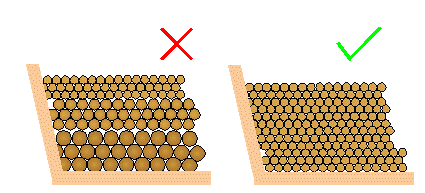

| Indice Principal | Indice General |
Los compuestos no necesitan contener ningun fertilizante, ya que tu debes abonar los arboles regularmente.
Antes de avanzar mas, necesitas conocer las preferencias del suelo del arbol en el que tu usaras el compuesto. Aparte de los nutrientes y elementos minerales en la tierra, hay otro aspecto quimico que debes conocer, y es la acides o alcalinidad del suelo. La mayoria de los arboles son indiferentes a esto, sin embargo las plantas Ericaeceous como las Azaleas y las Camelias deben tener un suelo acido, que usualmente es vendido en los centros de jardineria. Por favor no asumas que la turba (o substituto) es acido, es mas probable que se le haya agregado musgo.
There are a number of well known formulations for composts, and while the formulas are tried and tested the materials used in them often contain a lot of dust, which will be washed down to the bottom of the pot and form a solid mass, killing the roots and tree. Coniferous trees will benefit from grittier soil than Deciduous trees. A good general compost would be 50/25/25 Peat/Sand/Grit with 40/30/30 Peat/Sand/Grit for conifers. The sand should be Horticultural, or sieved sand as others contain a lot of fine dust.
I'd define grit as any stone that would pass through a sieve with a 4mm mesh but not through a 2mm mesh. These larger stones keep the soil open and allow air to get to the roots. The effect is reduced somewhat at the soil settles but it helps to promote root growth after repotting.
It also increases the drainage. The last thing most trees need is to be sitting in a wet mass of soil (although some trees will benifit from these conditions (Willows, Swamp cypress)), it's a gateway for fungal infections. Grit and Sand, it should be remembered will reduce the volume of water a given amount of soil can hold.
Here in the UK Horticultural Grit is available in any decent garden center, It's generally crushed, sieved granite.
If however you have access to someone who stocks either 'Akadama' or 'Kanuma' clays then you are well advised to use them. Akadama, for general use, Kanuma for acid loving trees such as Azeleas. These are granular clays, and provide a wonderful open soil, giving amazing root growth. Before use you should use a fine sieve, such as a flour sieve to remove any dust.
If you have purchased a bonsai from a non specialist supplier there is a likelihood that the tree was mass produced in China, the country where bonsai (pen-jing) originated. Look closely at the compost it is almost certainly clay, and you will not see grit or anything else that will open the soil and allow air to the roots. This clay will soon compact down as the tree is watered and choke the roots. The tree needs to be repotted at the earliest opportunity.
If you have not already done so, you may come across books on bonsai that recommend 'layering' the soil, Putting a coarse open soil at the bottom of the pot, building up to a fine soil at the top. This method provides excellent drainage but tends to keep most of the water at the top of the pot denying roots at the bottom enough water, while giving you an false impression that the tree is adequately watered. Current thinking is that one soil size throughout the pot is best, giving an equal distribition of water.

| >Main Index | General Index | Next section Creating a Bonsai | e-mail me |